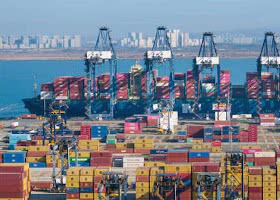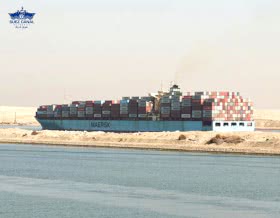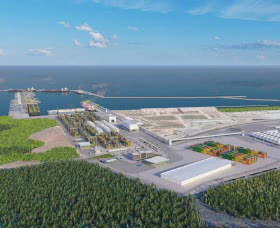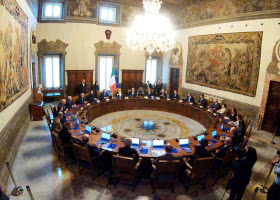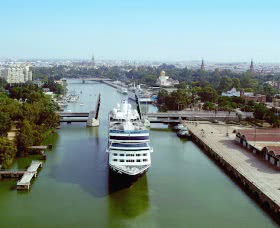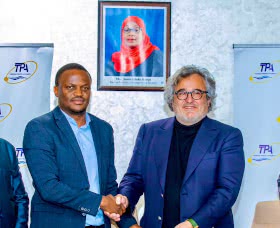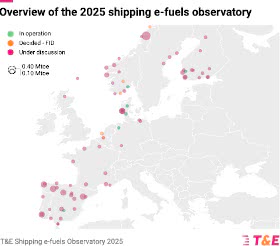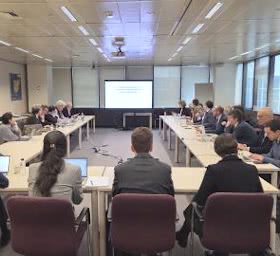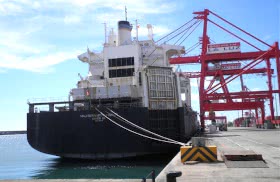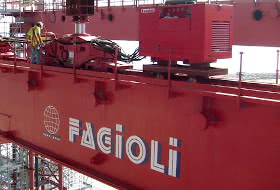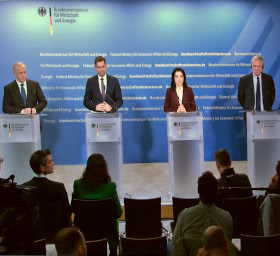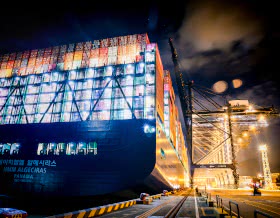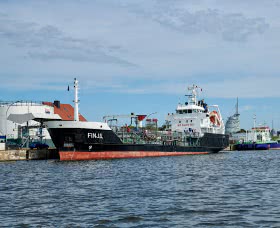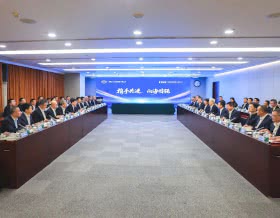Il settore del trasporto marittimo si è sempre storicamente
caratterizzato per l'elevata specializzazione e frammentazione
delle attività. Ogni spezzone, fondamentale od accessorio,
del ciclo trasportistico è diventato una professione riconosciuta
e remunerata.
Accanto ai ruoli chiave degli armatori e delle case di spedizione
internazionali, ruotano intorno al trasporto marittimo numerose
altre figure professionali che comprendono terminalisti, piloti,
ormeggiatori, provveditori di bordo, ship broker, spedizionieri
doganali, assicuratori, autotrasportatori e molti altri ancora.
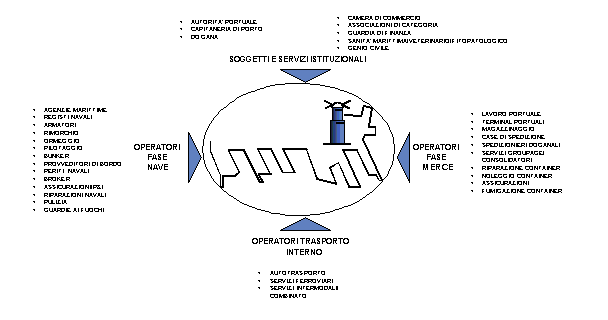
OPERATORI PRESENTI NELLA REALTA' PORTUALE
L'elevata specializzazione ha costituito nel corso dei secoli
un punto di forza del settore marittimo, ma ha d'altro canto generato
delle rendite di posizione che costituiscono un limite dal punto
di vista dell'efficienza e del contenimento dei costi complessivi
del trasporto per il cliente finale. Di fatto quindi oggi il
mercato genera una forte spinta verso il cambiamento e verso una
razionalizzazione dei servizi, fatto che ha portato allo scardinamento
di ruoli consolidati ed alla nascita di una nuova struttura del
sistema.
Le aziende continuano oggi a ristrutturare e semplificare le proprie
reti logistiche, cercando di rifornire i mercati da un minor numero
di magazzini, e riducendo la dimensione dei lotti trasportati
aumentando così la domanda di una sempre maggiore tempestività
delle consegne e della loro massima puntualità e precisione.
Il mercato richiede inoltre il ricorso a diverse modalità
di trasporto, le aziende richiedono trasportatori in grado di
assicurare servizi plurimodali, capaci di adattarsi alle necessità
ed alle convenienze. Infine cresce il numero delle aziende che
vogliono subappaltare non solo il trasporto, ma addirittura tutta
la distribuzione, e quindi cresce la domanda di servizi integrati
di distribuzione.
In conclusione aumentano i trasporti in termini di tonnellate/chilometro
trasportate, a causa dell'aumento delle distanze; contemporaneamente
però aumenta anche il frazionamento dei lotti trasportati
rendendo più complicata la gestione e richiedendo quindi
operatori sempre più professionali e specializzati.
Inoltre, anche nella distribuzione terrestre, inizia ad avere
sempre più larga diffusione l'utilizzo di HUB (centri di
smistamento centralizzati). Si assiste infatti ad un ridisegno
delle reti distributive: il sistema "HUB and Spoke"
(mozzo e raggi) sta sostituendo oggi il tradizionale sistema a
rete. Oltre a ridurre i collegamenti necessari per l'interscambio
delle merci, questa logica distributiva consente di concentrare
il traffico sui pochi punti (HUB) dai quali le merci si dipartono
verso i depositi periferici, dai quali hanno origine le consegne
finali su itinerari (spokes) ridotti.

Fonte: Il Sole-24 ore
L'attuale mercato del trasporto e del commercio mondiale richiede
quindi un'offerta di servizi sempre più sofisticata, ma
anche vasta, in una reale ottica di door to door su scala mondiale
e di gestione della logistica just in time. La globalizzazione
del mercato del trasporto marittimo ha inoltre portato le società
che vi operano ad una sempre maggiore competitività ed
aggressività.
Questo dinamismo del settore si riflette sull'organizzazione dei
trasporti marittimi e del lavoro portuale e, più in particolare,
sul ruolo dei soggetti coinvolti, sui rapporti e sul posizionamento
reciproco degli operatori.
Tra le varie azioni attuate dagli operatori in risposta ai mutamenti
del mercato, si rilevano principalmente le concentrazioni orizzontali
(accordi e fusioni) e le integrazioni verticali (integrazione
a monte ed a valle del proprio core business nella catena logistica)
di cui oggi tanto si parla.
Una delle strade perseguite è quindi quella delle fusioni,
acquisizioni od accordi su vasta scala fra grandi operatori al
fine di accrescere il controllo su di un mercato sempre più
complesso. Sono ormai dato di fatto grandi fusioni, incorporazioni
od accordi non solo nel settore del trasporto di linea container
(P&O con Nedlloyd, APL con MOL ed altre), ma in tutto il comparto
marittimo, nell'armamento e non: crociere (Carnival con Holland
American e Costa Crociere), dry bulk (Coeclerici con Sidermar
e Bulk Italia), terminal operators (partecipazioni azionarie di
terminal del Far East in quelli europei, e di quelli Nord europei
in porti Sud europei), case di spedizione (Luigi Serra con il
gruppo Tripcovich e la Gottardo Ruffoni), società di leasing
di equipment (la Trans American Leasing con la Trans Ocean e la
Caxu) ed altro ancora.
Queste grandi fusioni non mirano soltanto ad ottenere economie
di scala ma vengono utilizzate le esperienze complementari nei
vari mercati specializzati o di nicchia per avere una copertura
globale del mercato. Inoltre mediante gli accordi si mette in
comune anche l'organizzazione logistica di contorno, che oggi
assume sempre più rilevanza: servizi di trasporto, terminal,
magazzini, centri di distribuzione ed altro ancora.
Si ottiene quindi un'integrazione dei servizi con un'offerta completa:
in questo modo, governando in numero elevato e su base mondiale,
navi, strutture portuali e servizi terrestri si possono abbattere
in maniera significativa i costi door to door.
Nel processo di globalizzazione si assiste non solo alle grandi
concentrazioni tra potenze armatoriali, ma anche a nuove strategie
delle compagnie che vogliono gestire in proprio l'intera catena
della logistica e dell'intermodalità, seguendo tutto il
ciclo del container door to door con strutture e mezzi propri.
Oggi infatti una compagnia per poter "fornire logistica"
su scala mondiale, e sopportare quindi la concorrenza, deve possedere
non solo navi e contenitori in grandi quantità, ma anche
terminal dedicati, centri di smistamento interni, agenzie, compagnie
sussidiarie per la gestione dei trasporti stradali ed intermodali.
Si verifica quindi l'espansione degli operatori in mercati fino
ad oggi non legati alla loro gestione caratteristica, nella ricerca,
dal punto di vista delle possibilità di offerta, di una
migliore combinazione nella catena trasportistica del valore:
gli armatori si avvicinano alla professione di terminalisti, spedizionieri,
autotrasportatori, operatori intermodali ed agenti marittimi,
ma anche gli operatori di questi settori iniziano ad offrire i
loro servizi negli altri.
Non è infatti difficile trovare agenti marittimi che fanno
il lavoro delle case di spedizione o degli spedizionieri doganali,
si vedono case di spedizione che aprono e gestiscono società
di autotrasporto e logistica e, in alcuni casi, armano anche piccole
navi (ad esempio feeder).
Analizzando le tipologie di trasporto prevalenti nel commercio
estero dell'Italia si rileva una netta prevalenza del trasporto
marittimo. Il diagramma indica le percentuali delle diverse modalità
di trasporto calcolate sulle reciproche tonnellate trasportate;
necessariamente il trasporto via mare ha un peso rilevante visto
che sono prese in considerazione anche le rinfuse solide ed i
prodotti petroliferi, che in termini di tonnellate coprono una
gran parte delle importazioni del nostro paese.
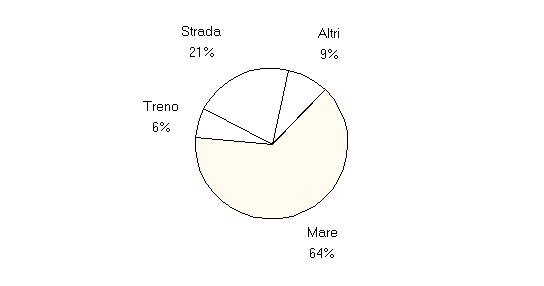
COMMERCIO ESTERO DELL'ITALIA PER SISTEMA
DI TRASPORTO - 1995
Fonte: EUROSTAT
Passando però ad analizzare la ripartizione percentuale
dei sistemi di trasporto interni in Italia, ed in alcune delle
principali nazioni europee, si vede che la situazione cambia ed
il trasporto su gomma ha il sopravvento sulle altre modalità
di trasporto in quasi tutti i paesi, ed in Italia in particolare.
| Italia
| Francia
| Germania
| Olanda
|
| Autotrasporto
| 72% |
58% | 54%
| 32% |
| Ferrovia
| 10% |
25% | 23%
| 5% |
| Cabotaggio
| 13% |
4% | 20%
| 56% |
| Altre modalità
| 5% |
13% | 3%
| 7% |
TRASPORTI INTERNI NEI PRINCIPALI PAESI UE
- 1996
(tonnellate per modalità di trasporto
- %)
Fonte: Containerization International Yearbook
La situazione in Italia è oggi critica non solo perché
la quantità di merci che viene trasportata via strada è
rilevante (72% del totale), ma anche perché questa percentuale
è in aumento a scapito delle altre modalità di trasporto,
meno inquinanti e meno congestionanti la mobilità del paese.
| 1970
| 1980
| 1990
| 1996
|
| Autotrasporto
| 45% |
57% | 64%
| 72% |
| Ferrovia
| 19% |
13% | 12%
| 10% |
| Cabotaggio
| 27% |
22% | 19%
| 13% |
| Altre modalità
| 9% |
8% | 5%
| 5% |
EVOLUZIONE DEI TRASPORTI INTERNI IN ITALIA
- 1970/1996
(tonnellate per modalità di trasporto
- %)
Fonte: Elaborazione Metis su dati Containerization
International Yearbook
La situazione dell'autotrasporto in Italia è anomala, se
confrontata con quella degli altri partner europei: le imprese
di autotrasporto in Italia sono 145 mila, in Francia sono 55 mila
ed in Germania 39.000; inoltre a fronte di 883 mila ton/km movimentate
in un anno da un'impresa italiana, un'impresa tedesca ne movimenta
tre milioni e 900 mila e una francese tre milioni e 200 mila.
Le aziende in Italia con un solo addetto, ovvero i "padroncini",
rappresentano i due terzi del settore, e se consideriamo anche
quelle con due addetti si raggiunge il 90%.
Il quadro del settore viene completato dall'andamento dei costi
che indica come un camion con targa italiana abbia costi mediamente
pari al doppio dei colleghi d'oltralpe.
Il costo medio annuo per un conducente in Italia è di 33.200
ECU, contro una media europea di circa 29.000 ECU (+ 14,5%), inoltre
l'Italia ha il minimo europeo di ore lavorabili contrattualmente,
con un conseguente minor numero di chilometri di percorrenza media
annua per autista (105 mila km contro una media europea di 110
mila km). L'indice di percorrenza a "vuoto", indicatore
di efficienza del sistema, in Italia è pari al 20%, contro
valori che in Europa variano dal 10% al 15%. Inoltre non deve
essere trascurato il fatto che nel nostro paese il prezzo del
gasolio per autotrazione è mediamente superiore del 10%
rispetto gli altri, e che le tariffe autostradali, con la sola
eccezione della Francia, sono di sei volte superiori ai valori
ipotizzati dalla Comunità Europea.
Attualmente, per fronteggiare la concorrenza dei grandi gruppi
europei del settore, è stato presentato un disegno di legge
atto a favorire concentrazioni aziendali nel settore e per un
rafforzamento delle stesse (il disegno di legge prevede incentivi
da 60 a 110 milioni alle piccole società di autotrasporto,
padroncini, che escono dal settore o si accorpano con altre.
Per contenere i costi ed offrire un servizio conveniente l'operatore
combinato (Multimodal Terminal Operator) deve essere in grado
di far effettuare al trazionista diversi trasporti al giorno (dopo
aver minimizzato le tratte camionistiche rispetto a quelle ferroviarie,
attraverso l'utilizzo spinto degli interporti), organizzandoli
in modo che alla consegna di un'unità di carico al terminal
di interscambio corrisponda, nella stessa località, il
ritiro di un'altra unità. Simili capacità, oggi
indispensabili, è difficile che siano garantite da un'impresa
che non abbia importanti traffici, e quindi ragguardevoli dimensioni.
Per una reale comparazione dei costi tra l'autotrasporto e le
altre modalità, oltre ai costi diretti, iniziano ad essere
presi in considerazione i costi indiretti.
Nel suo recente Libro Verde "Verso una corretta ed efficace
determinazione dei prezzi nel settore dei trasporti", anche
la Commissione della Comunità Europee indica strategie
di intervento per ridurre i notevoli divari che esistono tra i
prezzi corrisposti dai singoli utenti dei trasporti ed i costi,
anche indiretti, cui essi danno origine.
Vengono infatti considerati, anche i costi esterni per gli incidenti,
la rumorisità, l'inquinamento atmosferico ed il deterioramento
climatico (effetto serra).
A livello mondiale la spinta verso un trasporto intermodale sempre
più spinto vede sempre più ingenti investimenti
nel settore del trasporto ferroviario delle merci.
Negli Stati Uniti la modalità dei treni a due piani di
contenitori (double-stack container rail services) è oggi
sempre più diffusa e si iniziano a vedere i primi studi
di fattibilità anche in Europa, sulla linea Rotterdam -
Germania.
Sempre negli Stati Uniti le tratte ferroviarie hanno raggiunto
alte produttività ed un livello di costo così basso
che, dopo l'introduzione del contratto "Seatrain" (trasporto
a basso costo via ferrovia della merce europea che arriva a New
York per la California), c'è addirittura chi ipotizza che
in futuro sia possibile far arrivare nei porti pacifici americani
le merci provenienti dall'Estremo Oriente e destinate in Europa,
e quindi attraverso il trasporto ferroviario interno reimbarcarle
nei porti atlantici per l'inoltro a destino finale.
Nonostante quasi all'unanimità si ritenga necessario incrementare
le quote di trasporto merce via ferrovia, il mercato ferroviario
merci in Europa è in diminuzione in termini percentuali:
nel 1970 il 32% della merce gestita dai principali 15 paesi europei
viaggiava via ferrovia, nel 1996 questa percentuale è scesa
al 15%.
L'organizzazione dei caricatori European Shippers' Councils lamenta
il fatto che in Europa le ferrovie nazionali non sono sufficientemente
"customer oriented", sono inoltre spesso ritenute troppo
burocratizzate e poco flessibili.
Questa organizzazione internazionale ritiene che, per cambiare
le cose, la Comunità Europea dovrà spingere per:
· una gestione indipendente delle
infrastrutture ferroviarie;
· uguali possibilità di
accesso alle infrastrutture ferroviarie per tutti gli operatori;
· una piena applicazione delle
regole comunitarie sulla concorrenza;
· una riorganizzazione delle ferrovie
nazionali per adattarle alle richieste del mercato;
· una ristrutturazione finanziaria
delle ferrovie nazionali.
Il futuro del trasporto ferroviario potrà essere la razionalizzazione
dei servizi con la fornitura ai caricatori, agli spedizionieri
ed ai multimodal terminal operators di servizi spola multi clienti
tra centri di smistamento principali, a prezzi decisamente inferiori
rispetto ad oggi. Il modo per riguadagnare quote di mercato sul
tutto gomma, e sullo strapotere degli operatori Nord europei,
sarà l'organizzazione del servizio attraverso treni blocco
tra centri definiti a frequenze stabilite e garantite, ovvero
un minor numero di treni con un servizio di maggiore qualità
tra destinazioni strategiche per raggiungere le tariffe necessarie
per stare sul mercato.
Per dare qualche valore di riferimento sulla situazione attuale
del mercato Italiano, paragonato ad altri europei, da Rotterdam
a Monaco ci sono 3 treni navetta programmati alla settimana da
60 teu ciascuno, da Genova a Basilea con servizio navetta nel
mese di Marzo sono stati mossi 200 cntrs in export e 100 in import
ed un servizio navetta per Monaco a cadenza fissa, già
annunciato, è stato cancellato per mancanza di carico.
Per portare un altro esempio sui servizi a disposizione dei caricatori
l'italiana Cemat, in collaborazione con la svizzera Hupac e l'olandese
Trailstar, ha recentemente aggiunto un terzo collegamento ferroviario
quotidiano tra il Nord Italia ed il porto di Rotterdam, segno
di una crescita della domanda in tal senso.
Dal punto di vista dell'offerta infrastrutturale in Italia, in
uno studio datato 1995 del Freight Leaders Club è stata
calcolata la capacità residua di trasporto ferroviario
per alcune delle principali tratte ferroviarie. Ovvero si è
determinato quanti treni al giorno, passeggeri e merci programmati,
nei due sensi di marcia ogni tratta poteva sopportare in aggiunta
a quelli già previsti.
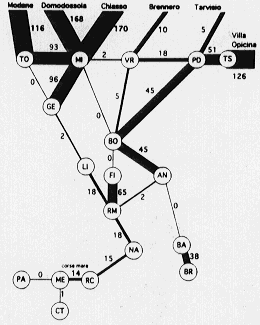
CAPACITA' RESIDUA TRASPORTO FERROVIARIO
(treni al giorno nei due sensi)
Fonte: Freight Leaders Club, 1995
Sempre in questa direzione si muove il progetto Kinnock delle
"Freeways", percorsi ferroviari internazionali sui quali
verrà indirizzato il traffico merci con accesso libero
anche ai privati con una gestione simile a quella del sistema
autostradale, anche se l'idea per il momento sembra essere di
difficile attuazione e trova molti oppositori.
Più in specifico la Direttiva 91/440 UE prevede una separazione
tra la gestione dei servizi ferroviari, che deve far capo ad imprese
private, e la proprietà e la manutenzione delle infrastrutture,
demandate all'intervento pubblico. La Direttiva vuole rendere
le ferrovie integrate, uniformi per tecnologia, con libertà
di accesso a pari pedaggio ed a pari costi, almeno sul 20% delle
tracce (la traccia corrisponde all'utilizzo di una tratta ferroviaria
per un determinato orario).
La politica perseguita dall'Unione Europea a favore del trasporto
intermodale, rispetto al trasporto stradale puro, prevede investimenti
in tutta Europa (ferrovie, strade, interporti) stimati in 400
miliardi di ECU entro l'anno 2010. Nel 1996 la Commissione Europea
ha stanziato 280 milioni di ECU, valore che per il 1997 sale a
352 milioni.
Fra i tanti progetti, il consiglio europeo ha fissato una priorità
per 14, che dovranno essere terminati entro il 1999. Fra le altre,
sono priorità del programma i servizi ferroviari passeggeri
e merci ad alta velocità che collegano gli aeroporti internazionali
ed i terminali dotati di dispositivi di alta tecnologia per lo
smaltimento veloce del trasporto combinato di merci su strada
e su rotaia.
L'incremento della domanda di servizi ferroviari (treni blocco)
a partenza prefissata tra centri di smistamento principali dove
possa avvenire l'interscambio tra le modalità di trasporto
ferroviaria e terrestre ha portato alla nascita di una fitta rete
di interporti.
Gli scopi che la creazione degli interporti cercano di perseguire
sono lo sviluppo del trasporto ferroviario e l'aumento dell'efficienza
delle società di trasporto o di servizi logistici private
ottenuta attraverso la concentrazione di più attività
differenti in un'unica località: mentre ogni infrastruttura
è un'entità separata, raggruppate tutte insieme
formano un sistema integrato. Nel diagramma in allegato viene
riportato un esempio delle attività, degli operatori e
dei servizi che dovrebbero essere presenti in un interporto.
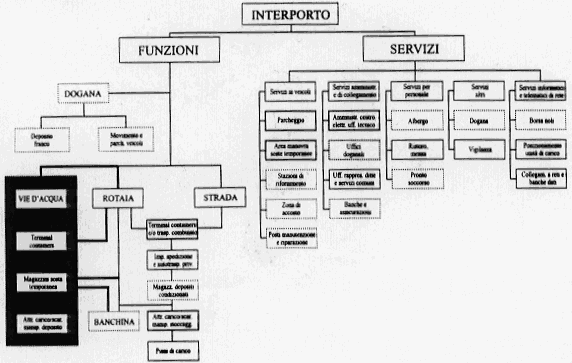
FUNZIONI E SERVIZI MINIMI DI UN INTERPORTO
Fonte: C.I.P.E.T., Piano quinquennale degli interporti.
In alcuni paesi del Nord Europa negli interporti, oltre alle modalità
di trasporto ferroviaria, stradale, ed in alcuni casi aerea (nel
caso di vicinanza di aeroporti), è presente anche un'ulteriore
modalità: il trasporto fluviale. Questa modalità,
poco diffusa in Italia, per alcuni paesi vista la conformazione
geografica diventa fondamentale, e lo si può vedere ad
esempio nel fatto che in Olanda il 56% dei trasporti interni avvenga
nel cabotaggio, e più in particolare nella navigazione
in canali.
Nel Nord America è presente una fitta rete di terminal
intermodali in grado di coprire e collegare tutto il territorio,
l'Europa è ancora indietro in questo campo. Nell'Unione
Europea gli stati membri continuano a destinare grosse somme per
finanziare lo sviluppo delle loro infrastrutture nel settore dei
trasporti, seguendo spesso esigenze e priorità nazionali.
Il risultato di tutto questo è il fatto che l'Europa attualmente
dispone più che altro di una matassa di infrastrutture,
ben lungi da essere una rete integrata, spesso lacunosa nei collegamenti
stradali, ferroviari, marittimi e fluviali, in particolar modo
tra le varie reti nazionali.
Sulla situazione Italiana viene riportata una tabella riassuntiva
di valutazione degli interporti stilata nel 1995 da una commissione
composta da fornitori di servizi e da utenti, oltre che da esperti.
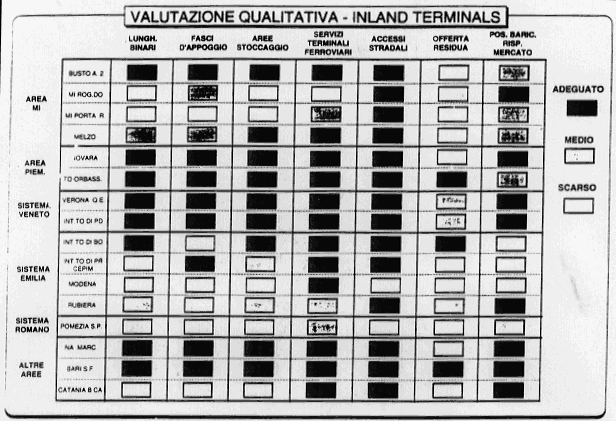
VALUTAZIONE QUALITATIVA INLAND TERMINALS
Fonte: Freight Leaders Club, L'intermodalità
terrestre, 1995
Attualmente in Italia il progetto più ambizioso in questo
settore è quello di Malpensa 2000: l'idea è quella
di creare un interporto di importanza europea, potendo disporre
non solo di aree a disposizione degli operatori e di collegamenti
stradali e ferroviari diretti, ma sfruttando anche la vicinanza
di porti importanti a livello internazionale, quali i porti liguri,
e di un aeroporto con servizi merci di linea importanti, senza
dimenticare la localizzazione in un hinterland particolarmente
ricco e dinamico.
Analizzando il mondo dei trasporti marittimi, non bisogna trascurare
un richiamo al trasporto aereo delle merci per vari motivi:
- è una modalità di trasporto che dimostra tassi
di crescita particolarmente dinamici;
- in alcuni casi la modalità aerea è, o può
diventare, concorrente e/o sostitutiva rispetto a quella marittima,
per cui non deve essere trascurata dagli operatori del settore;
- all'interno della tendenza di mercato, già analizzata,
che porta sempre più spesso alla nascita di "operatore
globali", già oggi esistono società che operano
sia in campo marittimo che in campo aereo merci (ad esempio Hapag
Lloyd ed Evergreen), potendo proporre ai propri clienti un'offerta
ad ampio raggio ed integrazioni logistiche non raggiungibili dagli
altri operatori.
Il traffico mondiale aereo merci ha continuato la sua crescita
nel 1996, raggiungendo i 13,3 milioni di tonnellate, con un incremento
di circa il 7% rispetto all'anno precedente; lo stesso incremento
percentuale si è riflesso anche sulle tonnellate trasportate
per chilometro, che a livello mondiale hanno raggiunto i 73,3
miliardi.
Il maggior sviluppo del traffico commerciale aereo si rileva però
nel settore passeggeri.
Anche in Italia ha mantenuto ritmi di crescita superiori a quelli
registrati dalle altre modalità di trasporto: in 30 anni,
dal 1965 al 1995, si è passati da 7,3 a 58,6 milioni di
passeggeri movimentati in Italia, con un incremento superiore
al 700%.
Analizzando i singoli aeroporti italiani, i maggiori incrementi
negli ultimi cinque anni si sono registrati nel campo passeggeri
a Firenze (+36% annuale), ad Ancona (+21%) ed a Milano Malpensa
(+10,2%); per le merci invece a Bergamo (+39%), a Bologna (+18,8%)
ed a Venezia Tessera (+13,3%).
| MOVIMENTO MERCI
(tonnellate)
| Incr.
%
| MOV. PASSEGGERI
(milioni pax.)
| Incr.
%
|
| 1993 | 496.667
| | 52,2 |
|
| 1994 | 526.920
| +6,1% | 55,6
| +6,5% |
| 1995 | 564.028
| +7% | 58,6
| +5,4% |
| 1996 (Provv.) | 579.256
| +2,7% | 64,9
| +10,7% |
TRAFFICO COMMERCIALE AEREO ITALIANO
Fonte: Ministero dei Trasporti e della Navigazione
Le attuali linee di tendenza portano a prevedere che nell'anno
2000 i passeggeri movimentati negli aeroporti italiani supereranno
i 70 milioni e che le merci a loro volta supereranno le 700.000
tonnellate.
E' comunque da rilevare come gli incrementi nel settore trasporto
aereo merci in Italia dimostrino una minore dinamicità
rispetto ai tassi di crescita che si riscontrano a livello mondiale,
come evidenziato nella tabella sottostante.
| % di incremento rispetto all'anno precedente.
| 1989 | 1990
| 1991 | 1992
| 1993 | 1994
| 1995 | 1996
|
MONDO
| 7%
| 3% | 0%
| 7% | 9%
| 13% | 8%
| 7% |
| ITALIA | |
| | | | 6,1%
| 7% | 2,7%
|
Questo è sintomo di un settore che non riesce ancora a
decollare come in altri paesi è avvenuto; inoltre in Italia
sono poco sfruttate le possibili sinergie ed integrazioni tra
la modalità aerea ed altre modalità di trasporto
(ferroviaria e marittima in particolare), integrazioni che invece
potrebbero costituire un vantaggio competitivo non trascurabile.









